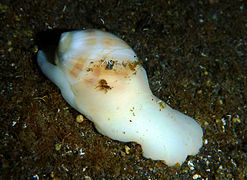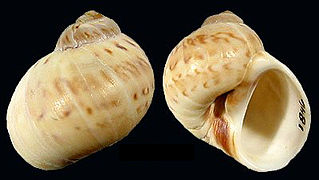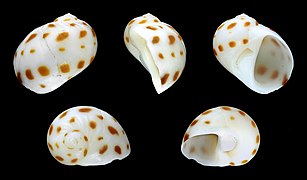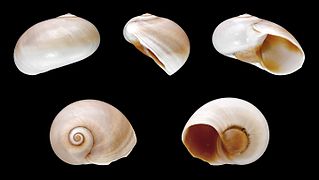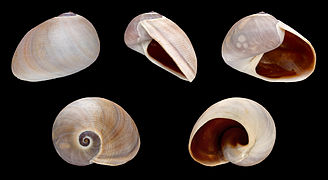|
Naticidae es una familia de moluscos gastrópodos del orden Caenogastropoda y la única de la superfamilia Naticoidea.[1]
La familia Naticidae fue creada por el teólogo y naturalista Reverendo Lansdowne Guilding (1797-1831) en 1834.[2]
Gran parte de las especies de esta familia realiza perforaciones en las conchas de sus presas, a través de la cual obtienen su alimento. Como consecuencia, dejan una bioerosión de contorno circular conocida como Oichnus paraboloides .[3][4][5]
Lista de géneros
- género Amauropsis Mörch, 1857
- género Benthobulbus McLean, 1995
- género Bulbus T. Brown, 1839
- género Calinaticina J. Q. Burch & Campbell, 1963
- género Conuber Finlay & Marwick, 1937
- género Cryptonatica Dall, 1892
- género Eunaticina P. Fischer, 1885
- género Euspira Agassiz in J. Sowerby, 1837
- género Falsilunatia Powell, 1951
- género Friginatica Hedley, 1916
- género Gennaeosinum Iredale, 1929
- género Globisinum Marwick, 1924
- género Glossaulax Pilsbry, 1929
- género Haliotinella Souverbie, 1875
- género Hypterita Woodring, 1957
- género Kerguelenatica Powell, 1951
- género Laguncula Benson, 1842
- género Mammilla Schumacher, 1817
|
- género Microlinices Simone, 2014
- género Natica Scopoli, 1777
- género Naticarius Duméril, 1805
- género Neverita Risso, 1826
- género Notocochlis Powell, 1933
- género Paratectonatica Azuma, 1961
- género Payraudeautia Bucquoy, Dautzenberg & Dollfus, 1883
- género Polinices Montfort, 1810
- género Proxiuber Powell, 1933
- género Pseudopolinices Golikov & Sirenko, 1983
- género Sigatica Meyer & Aldrich, 1886
- género Sinuber Powell, 1951
- género Sinum Röding, 1798
- género Stigmaulax Mörch, 1852
- género Tanea Marwick, 1931
- género Tasmatica Finlay & Marwick, 1937
- género Tectonatica Sacco, 1890
- género Uberella Finlay, 1928
|
Referencias
- ↑ «Molluscabase - Naticidae Guilding, 1834». www.molluscabase.org. Consultado el 14 de abril de 2023.
- ↑ Howard, R. A., & Howard, E. S. (1985). "The Reverend Lansdown Guilding, 1797-1831". Journal of the Arnold Arboretum. 37 (4): 401–402.
- ↑ Granville), Bromley, R. G., (Richard (11 de enero de 1981). Concepts in ichnotaxonomy illustrated by small round holes in shells. Universitat de Barcelona. OCLC 746735866. Consultado el 14 de abril de 2023.
- ↑ Zonneveld, John-Paul; Gingras, Murray K. (2014-09). «Sedilichnus, Oichnus, Fossichnus, and Tremichnus: ‘Small Round Holes in Shells’ Revisited». Journal of Paleontology 88 (5): 895-905. ISSN 0022-3360. doi:10.1017/s0022336000057565. Consultado el 14 de abril de 2023.
- ↑ Archuby, Fernando M.; Gordillo, Sandra (2018). «Drilling predation traces on recent limpets from northern Patagonia, Argentina». Palaeontologia electronica 21 (3). doi:10.26879/620. Consultado el 14 de abril de 2023.
Bibliografía relacionada
- Beu, A.G.; Marshall, B.A. 2011: New Cenozoic records of genera and families from New Zealand (Mollusca, Gastropoda): highlights from Phillip Maxwell's collection. New Zealand journal of geology and geophysics, 54(1): 13-34. doi 10.1080/00288306.2011.536517
- Guilding, L. 1834. Observations on Naticina and Dentalium, two genera of molluscous animals. Transactions of the Linnean Society of London 17: 29-35.
- Bouchet, P., & J.-P. Rocroi. 2005. Classification and nomenclator of gastropod families. Malacologia 47(1-2): 1-397.
- Huelsken, T. et al (2006) Neverita delessertiana (Recluz in Chenu, 1843): a naticid species (Gastropoda: Caenogastropoda) distinct from Neverita duplicata (Say, 1822) based on molecular data, morphological characters, and geographical distribution. Zootaxa, 1-25.
- Huelsken T. et al (2008) The Naticidae (Mollusca: Gastropoda) of Giglio Island (Tuscany, Italy): Shell characters, live animals, and a molecular analysis of egg masses. Zootaxa, 1770, 1-40.
Enlaces externos
|

